How to use gas detectors correctly: What to look out for before use
For industries such as chemical, gas, and metallurgical industries, gas detection is a very important safety procedure because there are irritating and suffocating gases in industrial production processes, which are often corrosive and can cause acute poisoning when entering the human body through the respiratory tract. Therefore, gas detectors have been widely used in various industries.
Before using the gas detector:
① Before homework, carefully read the corresponding user manual for the gas detector and familiarize yourself with the machine's performance and operating methods.
② Check if the battery level is sufficient, and if it is found to be low, replace the battery in a timely manner.
③ Check if there are any debris blocking the intake air filter, which needs to be cleaned or replaced.
④ Press and hold the start button for three seconds during startup to enter self check mode. Observe whether the low and high alarm values set by the detector are accurate (CO detector has a first level alarm of 50ppm and a second level alarm of 100ppm; oxygen detector has a first level alarm of 19.5% and a second level alarm of 22%; hydrogen sulfide detector has a first level alarm of 10ppm and a second level alarm of 15ppm). If the settings do not meet the requirements, it is not allowed to use and should be corrected immediately.
⑤ During the self check during the startup process, you should listen for the accuracy of the graded alarm sound and light alarm and vibration alarm. If they do not meet the requirements, they should not be used and should be corrected immediately.
⑥ After starting up under fresh air conditions, observe whether the initial value is accurate (the CO detector initially displays 0 ppm; the O2 detector initially displays 20.9%; The initial display of the hydrogen sulfide detector is 0 ppm. If the displayed value is inaccurate, it is strictly prohibited to use and should be corrected immediately.






